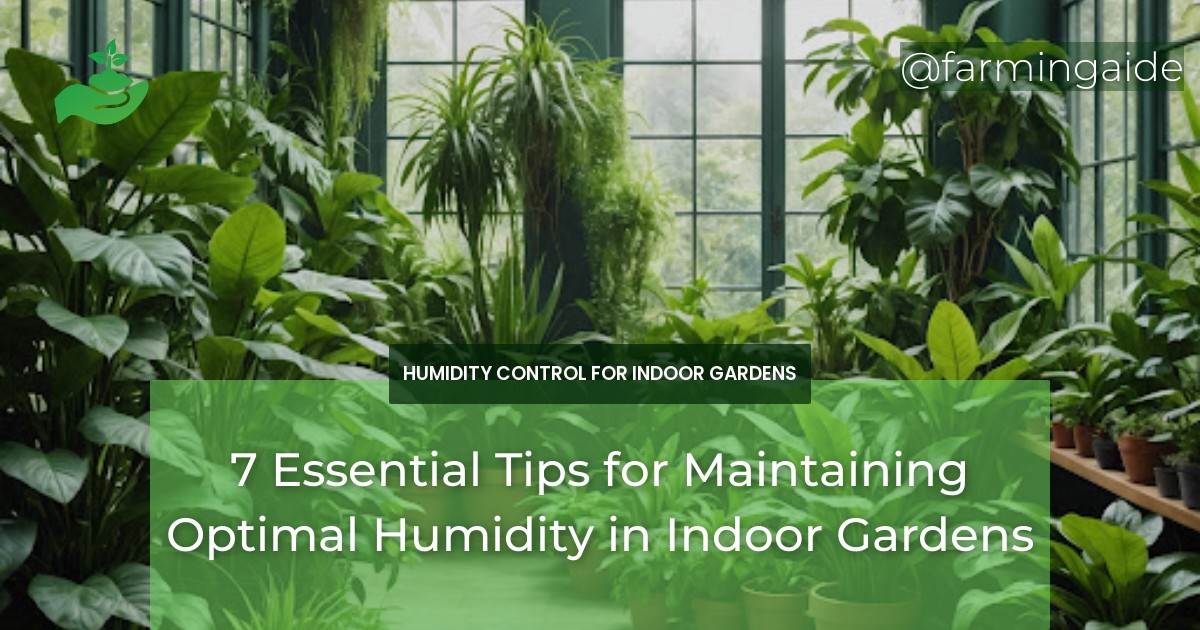When it comes to creating a thriving indoor garden, many gardeners focus on providing their plants with the right amount of light, water, and nutrients. However, humidity is an often-overlooked but crucial factor in indoor plant care. Maintaining optimal humidity levels can make all the difference in promoting healthy plant growth, preventing diseases, and creating a balanced ecosystem. In this article, we’ll delve into the importance of humidity in indoor gardening, discuss ideal humidity levels for different plants, and provide practical tips for measuring, controlling, and maintaining optimal humidity levels.
Key Takeaways
- Understanding the importance of humidity in indoor gardening
- Identifying ideal humidity levels for different plants
- Measuring and monitoring humidity levels
- Implementing effective humidity control strategies
- Practical tips for daily humidity maintenance and seasonal adjustments
Table of Contents
Understanding Humidity in Indoor Gardening
Humidity refers to the amount of moisture in the air. In indoor gardens, humidity levels can fluctuate greatly depending on factors such as temperature, ventilation, and the number of plants. Most plants thrive in a humid environment, typically between 40-60% relative humidity (RH). However, some plants require more or less humidity, and understanding these specific needs is crucial for optimal plant health.
Importance of Humidity for Indoor Plants
Humidity plays a vital role in plant growth and development. It helps regulate transpiration, prevents water stress, and promotes healthy root growth. In dry environments, plants may experience stress, leading to issues such as leaf drop, yellowing, or browning. On the other hand, high humidity can lead to fungal diseases and root rot. By maintaining optimal humidity levels, you can create a balanced environment that supports healthy plant growth.
Ideal Humidity Levels for Different Plants
Different plants have varying humidity requirements. For example:
| Plant Type | Ideal Humidity Level |
|---|---|
| Tropical plants (e.g., Ferns, Peace Lilies) | 60-80% |
| Succulents and Cacti | 40-50% |
| Herbs and Vegetables | 50-60% |
| Flowering plants (e.g., African Violets, Begonias) | 50-70% |
It’s essential to research the specific humidity needs of your plants to ensure you’re providing the optimal environment.
Measuring and Monitoring Humidity
To maintain optimal humidity levels, you need to measure and monitor humidity regularly. Fortunately, there are several tools and techniques to help you do so.
Tools for Measuring Humidity
Hygrometers are devices that measure relative humidity. You can find hygrometers in various forms, including:
- Digital hygrometers: Accurate and easy to use
- Analog hygrometers: Less accurate but still effective
- Thermohygrometers: Measure both temperature and humidity
Regular Monitoring Techniques
In addition to using hygrometers, you can monitor humidity by observing your plants. Look for signs of water stress, such as leaf droop or yellowing, which can indicate low humidity. Conversely, fungal diseases or root rot may indicate high humidity.
ALSO READ
Effective Humidity Control Strategies
To maintain optimal humidity levels, you need to implement effective control strategies. Here are a few techniques to consider:
Using Humidifiers and Dehumidifiers
Humidifiers add moisture to the air, while dehumidifiers remove excess moisture. These devices can be especially useful in extreme humidity environments.
Watering Techniques for Humidity Control
Watering techniques can also impact humidity levels. For example:
- Misting: Increases humidity through frequent, light watering
- Drenching: Reduces humidity by watering plants thoroughly and allowing the soil to dry slightly between waterings
The Role of Ventilation in Humidity Management
Ventilation plays a crucial role in humidity management. Proper ventilation helps regulate humidity levels by allowing excess moisture to escape and fresh air to enter the environment.
Practical Tips for Daily Humidity Maintenance
In addition to implementing control strategies, there are several daily maintenance tips to help you maintain optimal humidity levels.
Grouping Plants for Shared Humidity
Grouping plants with similar humidity requirements can create a microclimate that supports optimal humidity levels.
The Impact of Container Types on Humidity
Container types can affect humidity levels. For example, terracotta pots tend to dry out faster than plastic pots, which can lead to lower humidity levels.
Seasonal Adjustments for Humidity Control
Humidity levels can fluctuate with the seasons. Here are some tips for making seasonal adjustments:
Adjusting Humidity Levels with Seasons
In the winter, humidity levels tend to be lower due to dry air. In the summer, humidity levels can be higher due to increased temperatures and moisture.
Winter and Summer Humidity Management
In the winter, consider using humidifiers to maintain optimal humidity levels. In the summer, ensure good ventilation to prevent excessive humidity buildup.
ALSO READ
Common Mistakes and Solutions in Humidity Management
Even with the best intentions, mistakes can occur in humidity management. Here are some common mistakes and solutions:
Overwatering and Its Effects on Humidity
Overwatering can lead to high humidity levels, which can promote fungal diseases and root rot. Solution: Monitor soil moisture levels and adjust watering schedules accordingly.
Correcting High or Low Humidity Issues
If you notice high or low humidity levels, adjust your control strategies accordingly. For example, use humidifiers or dehumidifiers to regulate humidity levels.
Conclusion: Mastering Humidity for a Thriving Indoor Garden
Maintaining optimal humidity levels is crucial for creating a thriving indoor garden. By understanding the importance of humidity, measuring and monitoring humidity levels, implementing effective control strategies, and making seasonal adjustments, you can create a balanced environment that supports healthy plant growth. Remember to avoid common mistakes, such as overwatering, and correct any humidity issues promptly. With these tips and techniques, you’ll be well on your way to mastering humidity and enjoying a lush, vibrant indoor garden.


